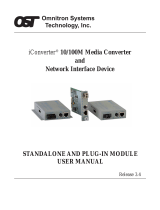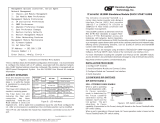Page is loading ...

iConverter 10/100M Plug-in Module QUICK START GUIDE
The Omnitron iConverter
®
10/100M Plug-In is a carrier-class
media converter and a Network Interface Device (NID) that
provides 10BASE-T or 100BASE-TX (10/100) to 100BASE-FX
Fiber media conversion with integrated management.
The 10/100M conforms to Ethernet in the First Mile (EFM) fiber
standards to support Fiber-to-the-X (FTTX) Metropolitan access
and Enterprise LAN networks. Built-in Operation, Administration
and Maintenance (OAM) functionality enables the 10/100M to
operate as a managed copper demarcation point at the customer
premises and network edge, offering service provisioning
functions, such as Quality of Service and Bandwidth Control
(rate-limiting) capabilities.
The 10/100M module can be managed using Omnitron’s NetOulook
TM
SNMP
Management Software, Telnet or the Command Line Interface (CLI).
For more information, including the complete User Manual on the 10/100M Plug-in
module, access Omnitron’s documentation download web page to view all relevant
documents:
http://www.omnitron-systems.com/downloads.php
INSTALLATION PROCEDURE
1) Configure DIP-Switches
2) Install Module in Chassis and Connect Cables
3) Configure Module via Command Line Interface
4) Verify Operation
1) CONFIGURE DIP-SWITCHES
DIP-SWITCH BANK 1
SW1 - UTP/FIBER PAUSE ENABLE
When a port is operating in Auto-Negotiation
(AN), its Pause operation mode is determined
by the Pause capability advertised during AN
between itself and the link partner. The port
advertises its Pause capability (Symmetrical or
No Pause) during AN based on the Pause
Disable/Enable DIP-switch setting.
When a port is operating in Manual mode, its
Pause operation mode is based on the Pause
Disable/Enable DIP-switch setting.
SW2 - FIBER FULL/HALF DUPLEX
Setting this DIP-switch to Half-Duplex “HDX” facilitates a connection that supports
Half-Duplex. Setting this DIP-switch to Full-Duplex “FDX” facilitates a connection that
supports Full-Duplex operation.
Management Options iConverter, Serial Agent
Network Management
1: Chassis and Module Management
2: Set Module Name Preferences
Management Module Preferences
3: IP and Control Preferences
4: SNMP Preferences
5: Abandon Preference Changes
6: Save Preference Changes
7: Restore Factory Defaults
8: Restart Management Module
9: Other Networking Features
Management Module Maintenance
10: Firmware Update
11: Set Date/Time
IP Address = 192.168.1.220
Chassis Number = 1
Enter Choice, <H>elp, E<x>it >
Figure D: Command Line Interface Menu Options
The CLI interface allows for the detailed configuration of the module. It is recommended
to configure the module with an IP address associated with the attached network.
Also, SNMP traphost address should be configured if the module is managed with an
SNMP-based Management System. See the 10/100M User Manual for complete
information.
4) VERIFY OPERATION
Once the module has been
installed and configured per steps
1 - 3, verify the module is
operational by viewing the LED
indicators.
The Power LED indicates the
module is receiving power from
the chassis.
The Fiber Optic link LED indicates
the fiber optic connection has
been established. Verify the Link
Mode selection is set to Link
Segment (LS). Until a stable link
is established, leave the Link
Mode configured for LS. After a
Link presence is established, the Link Mode selection can be modified.
The UTP link LED indicates the module has established a connection across its UTP
port.
Switch 1
Switch 8
LEFT
Switch 1
Switch 8
Bank 2
Bank 1
RIGHT
Figure A: DIP-Switch Locations
LED Function
"Legend"
Color OFF State ON / Blinking State
Power "Pwr" Amber No power Module has power
Power Supply
Status "PSx"
Amber
Power Supply
not installed
ON: Power Available
Blinking: No power available
from "PSx"
Network Ports Status*
Fiber Optics
"FO"
Green No Fiber Link
ON: Fiber link is active
Blinking: Fiber Data Activity
Master/Slave
"BP"
Green Slave Mode Master Mode
1
0Mbps UTP
"10"
Green
10Mbps not selected
or disconnected
ON: Active 10Mbps UTP link
Blinking: UTP Data Activity
1
00Mbps UTP
"100"
Green
100Mbps not selected
or disconnected
ON: Active100Mbps UTP link
Blinking: UTP Data Activity
UTP Full-Duplex
"FDX"
Green Half-Duplex Full-Duplex
*Review Link Modes section for other LED display patterns
Figure E: LED Indicators
Form 040-08900-002 J 12/07
Omnitron Systems Technology * 140 Technology Dr. #500 * Irvine, CA 92618
949.250.6510 tel * 949.250.6514 fax * www.omnitron-systems.com

Management Module (NMM), set the
DIP-switch to the LEFT “M/SL”
position (factory default). The
assignment of mastership is
automatically negotiated by the
installed management modules.
To designate the 10/100M module
as the master of the chassis, set the
DIP-switch on the module to the
LEFT “M/SL” position, and set the
other installed management
modules’ DIP-switches to the RIGHT
“SL” position to enable Slave-Only mode.
2) INSTALL MODULE IN CHASSIS AND CONNECT CABLES
a. Carefully slide the module into an open slot in the chassis. Align the module with
the installation guides and ensure that the module is firmly seated against the
backplane. Secure the module by fastening the front panel thumbscrew (push in
and turn clockwise to tighten) to the chassis front. Verify the “Pwr” LED is ON
(indicating the chassis is powered).
b. When using a 10/100M SFP model (8919-0), insert the SFP Fiber transceiver into
the Port 1 SFP receptacle on the 10/100M.
NOTE: The release latch of the SFP Fiber transceiver must be in the closed
position before insertion.
c. Connect the UTP port via a Category 5 cable to a 10BASE-T or 100BASE-TX
Ethernet device.
d. Connect an appropriate multimode or single-mode fiber cable to the fiber port of
the installed module. It is important to ensure that the transmit (TX) is attached to
the receive side of the device at the other end and the receive (RX) is attached to
the transmit side. Single-fiber (SF) media converter models operate in pairs. The
TX wavelength must match the RX wavelength at the other end and the RX
wavelength must match the TX wavelength at the other end.
3) CONFIGURE MODULE VIA COMMAND LINE INTERFACE
To access the Command Line Interface (CLI), connect the 10/100M RS-232 Console
Port to the COM port of a computer equipped with terminal emulation software such as
HyperTerminal. The Console Port (DCE) is a mini DIN-6 female connector which can
be changed to a DB-9 connector with the included adapter. The 10/100M Console
Port is a standard asynchronous serial interface.
Start HyperTerminal and select the correct COM Port in the HyperTerminal “Connect
To:” window. Set the serial port to the following:
Bits Per Second 57,600
Stop Bits 1
Data Bits 8
Parity NONE
Hardware Flow Control NONE
Once connected, press <ENTER> to bring up a command line prompt on the attached
PC.
SW3 - UTP AUTO/MANUAL
When this DIP-switch is in the UTP Auto Negotiate “AN” position (factory default), the UTP
port automatically determines the speed and duplex mode of the connecting UTP device.
When the UTP “AN/Man” DIP-switch is in the Auto Negotiate “AN” position and the
UTP 10/100 DIP-switch is in the “100” position, the UTP port auto-negotiates to 100Mbps
or 10Mbps. When in the “10” position, the UTP port only operates at 10Mbps
When the UTP “AN/Man” DIP-switch is in the Auto Negotiate “AN” position, and the
UTP Full/Half-Duplex DIP-switch is in the Full-Duplex “FDX” position, the UTP port
auto negotiates to Full or Half-Duplex. When in the Half-Duplex “HDX” position, the
UTP port functions only in Half-Duplex.
SW4 - UTP 10/100Mbps
When the UTP “AN/Man” DIP-switch is in the manual “Man” position, the “10/100"
DIP-switch determines the speed of operation for the UTP port.
SW5 - UTP FULL/HALF DUPLEX
When the UTP “AN/Man” DIP-switch is in the manual “Man” position, the UTP
Full/Half-Duplex “FDX/HDX” DIP-switch determines the duplex operation mode
of the UTP port.
SW6, SW7, SW8 - LINK MODES
The module supports multiple link modes for fault detection and isolation. Link Segment
should be used for the initial installation of the module. Once installed and operational,
the link mode can be modified.
S
witch Left
(Factory Default)
Right SW6 SW7 SW8 Link Mode Selection
SW1 Off:
Pause Disable
PAUS:
Pause Enable
Left Left Left Link Segment (LS)
(Factory Default)
SW2 FDX:
Fiber Full-Duplex
HDX:
Fiber Half-Duplex
Right Left Left Link Propagate (LP)
SW3 AN:
UTP Auto-Negotiate
MAN:
UTP Manual
Left Right Left Remote Fault Detect + Link
Segment (RFD + LS)
SW4 100:
UTP 100Mbps
10:
UTP 10Mbps
Right Right Left Remote Fault Detect + Link
Propagate (RFD + LP)
SW5 FDX:
UTP Full-Duplex
HDX:
UTP Half-Duplex
Left Left Right Symmetrical Fault Detect (SFD)
SW6 See Link Mode Selection Right Left Right Illegal Setting
SW7 See Link Mode Selection Left Right Right Illegal Setting
SW8 See Link Mode Selection Right Right Right Illegal Setting
Figure B: DIP-Switch Bank 1
DIP-SWITCH BANK 2
SW1, SW2 - BACKPLANE ENABLE
When the DIP-switch is in the LEFT “DS” position (factory default), the Backplane Port
of the 10/100M is isolated from the chassis’ Ethernet Backplane. When the DIP-
switch is in the RIGHT “EN” position, the Backplane Port is enabled. This allows Ethernet
Backplane connectivity to an adjacent module via the chassis Backplane Link “A” or
“B” depending on the switch setting.
SW4 - MASTER/SLAVE
When the 10/100M module is installed in a chassis with an
iConverter Network
Switch Left
(Factory Default)
Right
SW1 A-DS:
Port A Disabled
A-EN:
Port A Enabled
SW2 B-DS:
Port B Disabled
B-EN:
Port B Enabled
SW3 Reserved Reserved
SW4 M/SL:
Auto Select
SL:
Slave-Mode Only
SW5 - SW8 Reserved Reserved
Figure C: DIP-Switch Bank 2
/





